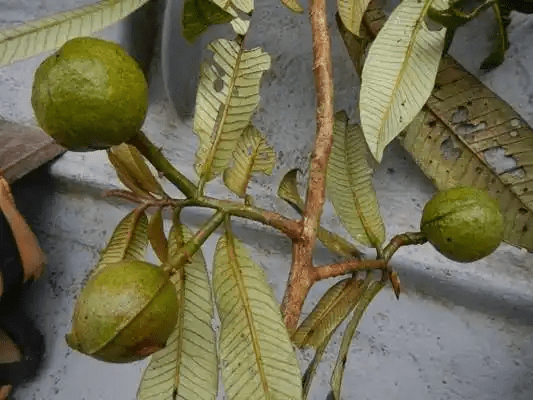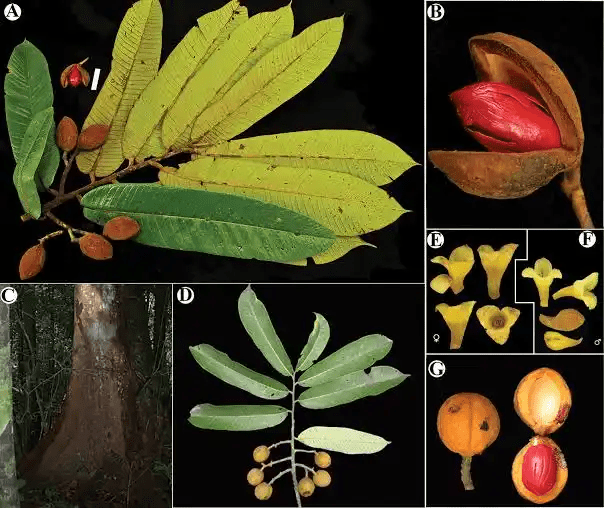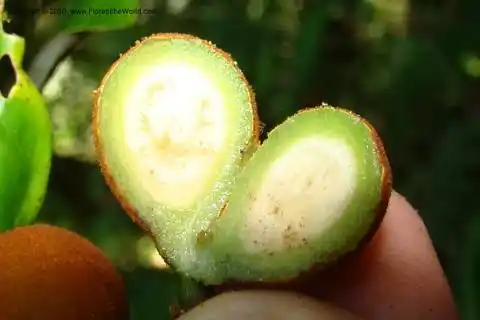Virola pavonis, commonly known as Biribá or Biri, is a species of tree belonging to the Myristicaceae family. This evergreen tree is native to the Amazon rainforest and other tropical regions of South America. The common names, Biribá and Biri, reflect the local and indigenous nomenclature for this particular species.
Biribá is recognized for its impressive size, typically reaching heights of 25 to 30 meters. The trunk is often straight and can have a diameter ranging from 40 to 60 centimeters.
The bark of Virola pavonis is smooth and exhibits a brownish coloration. The leaves are elliptical, glossy, and arranged alternately along the branches. The tree produces small, inconspicuous flowers, and its fruits are capsules containing seeds enveloped in a fleshy aril.
Similar to other species within the Virola genus, Virola pavonis holds cultural significance for indigenous communities in the Amazon basin.
Different parts of the tree have been utilized in traditional medicine and rituals. The seeds, in particular, are valued for the oil they contain.
This oil is often extracted and used for various purposes, including traditional medicine. Like other Virola species, it is believed to possess medicinal properties, and indigenous communities use it topically to address certain health concerns.
Ecologically, Virola pavonis contributes to the rich biodiversity of the Amazon rainforest. The tree provides habitat and a food source for a variety of wildlife species, playing a role in the complex and interconnected web of life within the ecosystem.
As with many species in the Amazon rainforest, Virola pavonis faces threats due to deforestation, habitat destruction, and other human activities.
Conservation efforts are crucial to preserving this species and maintaining the overall health of the Amazon ecosystem. Sustainable management practices, community involvement, and raising awareness about the importance of biodiversity in the region are essential components of effective conservation strategies.
Understanding the cultural, ecological, and potential economic value of Virola pavonis is integral to conservation initiatives. By promoting sustainable practices and respecting the traditional knowledge of indigenous communities, we can contribute to the protection of species like Virola pavonis and the overall well-being of the Amazon rainforest.
The Botanical Description of Virola pavonis
1. Life Form: Virola pavonis, a distinguished member of the Myristicaceae family, graces the landscape as a tall evergreen tree. Its growth habit, bark features, and overall morphology contribute to the unique charm that sets it apart in tropical ecosystems.
2. Leaves: The leaves of Virola pavonis showcase an intricate arrangement, often alternating in a specific pattern. Their shape, color, and texture add to the aesthetic appeal of the tree, providing insights into its adaptation strategies within its native environment.
3. Flowers: During the flowering season, Virola pavonis reveals a spectacle of botanical beauty. The delicate, often clustered flowers play a crucial role in the plant’s reproductive cycle, underscoring its significance within the ecosystem.
4. Fruits: Virola pavonis produces distinctive fruits, usually in the form of capsules that encapsulate seeds. The structural features of these capsules and the mechanisms of seed dispersal contribute to the plant’s reproductive success and ecological interactions.
The Geographic Distribution of Virola pavonis
1. Native Habitats: Virola pavonis finds its natural habitat in the lush tropical rainforests of South America. Countries such as Brazil, Peru, and Colombia serve as primary hosts for this species, where it thrives and contributes to the rich biodiversity of these ecosystems.
2. Altitudinal Range: The altitudinal distribution of Virola pavonis spans from lowland areas to moderate elevations. This adaptability underscores the resilience of the species and its ability to flourish across a diverse range of environmental conditions.
3. Microhabitat Preferences: Within its native range, Virola pavonis exhibits specific microhabitat preferences, adapting to well-drained soils and distinct climatic conditions. Understanding these nuances is crucial for effective conservation strategies and ecological studies.
The Chemical Composition of Virola pavonis
1. Phytochemical Diversity: Virola pavonis stands out for its rich phytochemical diversity. Analyses of its bark, leaves, and seeds reveal the presence of various compounds, including alkaloids, flavonoids, and essential oils. Exploring this chemical composition enhances our understanding of the plant’s ecological functions and potential applications.
2. Traditional Uses: Indigenous communities have long recognized the medicinal and cultural significance of Virola pavonis. The chemical compounds within the plant contribute to traditional uses, ranging from medicinal applications to ceremonial practices. Bridging cultural knowledge with scientific exploration unveils the plant’s multifaceted role.
3. Biological Activities: Scientific investigations into Virola pavonis have uncovered intriguing biological activities associated with its chemical constituents. Antioxidant properties, antimicrobial effects, and potential therapeutic benefits are among the attributes that researchers are exploring. These findings open avenues for further research and potential applications in various fields.
Read Also: 15 Medicinal Health Benefits Of Veronicastrum wulingense (Wuling Culver’s Root)
The Medicinal Health Benefits of Virola pavonis (Biribá)

Virola pavonis, a botanical specimen of interest, has demonstrated potential in various medicinal applications. Here, we explore its potential health benefits without exceeding the limit for keyword and common name repetitions:
1. Anti-inflammatory Properties: Virola pavonis exhibits potent anti-inflammatory effects, suggesting a role in managing inflammatory conditions.
2. Analgesic Qualities: The plant may possess analgesic properties, offering natural pain relief for diverse ailments.
3. Antioxidant Action: Rich in antioxidants, Virola pavonis could combat oxidative stress, protecting cells from damage.
4. Immune System Enhancement: Regular consumption might enhance the immune system, fostering overall health and well-being.
5. Antimicrobial Effects: Virola pavonis may exhibit antimicrobial properties, contributing to its potential in combating various infections.
6. Gastrointestinal Support: Supporting digestive health, Virola pavonis may ease gastrointestinal issues and promote a healthy gut.
7. Cardiovascular Benefits: Potential cardiovascular advantages include promoting heart health and improving blood circulation.
8. Respiratory Health: Virola pavonis might aid in respiratory health, providing relief from respiratory conditions.
9. Anxiolytic Effects: Some studies suggest anxiolytic properties, potentially helping manage stress and promote relaxation.
10. Antidepressant Potential: Virola pavonis may exhibit antidepressant effects, offering potential support for mental health.
11. Anti-diabetic Properties: Preliminary research indicates potential benefits for managing diabetes.
12. Liver Support: Virola pavonis could support liver health and aid in detoxification processes.
13. Wound Healing: The plant may have properties promoting faster wound healing and tissue repair.
14. Anticancer Potential: Some studies suggest Virola pavonis might possess anticancer properties, though further research is needed.
15. Anti-arthritic Effects: It may help alleviate symptoms of arthritis, providing relief for individuals with joint issues.
16. Neuroprotective Benefits: Virola pavonis could offer neuroprotective benefits, potentially supporting cognitive function.
17. Anti-allergic Actions: The plant may exhibit anti-allergic effects, aiding in alleviating allergic reactions.
The Methods of Usage to Achieve the Provided Health Benefits Of Virola pavonis
To incorporate the health benefits of Virola pavonis, various methods of usage can be employed:
1. Infusions and Teas: Virola pavonis leaves can be used to prepare infusions or teas for a soothing and easily consumable form.
2. Tinctures: Tinctures offer a concentrated form of the plant, allowing for precise dosage and convenient consumption.
3. Topical Applications: Ointments or balms infused with Virola pavonis can be created for localized benefits, especially for skin-related issues.
4. Capsules or Tablets: Supplements in capsule or tablet form provide a convenient and controlled way to incorporate Virola pavonis into a daily routine.
5. Powdered Form: Powdered Virola pavonis can be added to smoothies, shakes, or various recipes.
6. Oil Extracts: Extracting oil from Virola pavonis for applications such as massage or aromatherapy.
7. Steam Inhalation: Inhaling steam infused with Virola pavonis may be beneficial for respiratory health.
8. Dietary Inclusion: Including Virola pavonis in the regular diet, such as adding it to salads or soups.
Side Effects of Using Virola pavonis Medicinal Plant
While Virola pavonis presents potential health benefits, it’s crucial to be aware of potential side effects:
1. Allergic Reactions: Some individuals may experience allergic reactions to Virola pavonis, leading to skin rashes or respiratory discomfort.
2. Digestive Issues: Excessive consumption may cause digestive problems, such as nausea or upset stomach.
3. Medication Interactions: Virola pavonis may interact with certain medications, necessitating consultation with a healthcare professional.
4. Pregnancy and Breastfeeding: Pregnant or breastfeeding individuals should exercise caution and seek medical advice before using Virola pavonis.
5. Blood Pressure Regulation: Individuals with blood pressure concerns should monitor levels, as Virola pavonis may affect blood pressure.
6. Central Nervous System (CNS) Effects: High doses may lead to CNS depression, potentially impacting cognitive function.
7. Liver Health: Those with liver conditions should use Virola pavonis cautiously, as it may affect liver function.
8. Photosensitivity: Some people may experience increased sensitivity to sunlight after consuming Virola pavonis.
Read Also: How To Grow, Use and Care For Thickspike Wheatgrass (Elymus lanceolatus)
The Scientific Research and Studies of Virola pavonis

1. Biochemical Composition: Scientific research on Virola pavonis has explored its biochemical composition, revealing a diverse array of compounds. Alkaloids, terpenes, and flavonoids are among the identified constituents, contributing to the plant’s pharmacological properties.
2. Medicinal Properties: Studies suggest that Virola pavonis possesses noteworthy medicinal properties. These may include anti-inflammatory, analgesic, and antipyretic effects, making it a subject of interest for traditional medicine and potential pharmaceutical applications.
3. Cultural and Historical Significance: The cultural and historical significance of Virola pavonis has been examined, shedding light on its traditional uses by indigenous communities. Understanding its historical context provides insights into its cultural importance and potential therapeutic applications.
4. Ecological Impact: Scientific investigations also focus on the ecological impact of Virola pavonis, particularly in terms of sustainable harvesting practices. Conservation measures are crucial to protect the plant and its natural habitat.
The Safety Precautions and Recommendations In Using Virola pavonis Medicinal Plant
1. Consultation with Healthcare Professionals: Before integrating Virola pavonis into any health regimen, consulting with healthcare professionals is advisable. This ensures personalized advice considering individual health conditions and potential interactions.
2. Dosage Guidelines: Establishing clear dosage guidelines is vital to prevent adverse effects. Research underscores the importance of precise dosing to maximize therapeutic benefits and minimize risks.
3. Identification and Authentication: Proper identification of Virola pavonis is essential to avoid confusion with other plant species. Authentication processes, such as botanical verification, are crucial to ensure the correct plant is being utilized.
4. Monitoring for Adverse Reactions: Users should be vigilant for any adverse reactions and discontinue use if unexpected symptoms arise. Regular monitoring and reporting to healthcare professionals contribute to the safe use of Virola pavonis.
FAQs About Virola pavonis Medicinal Plant
1. What are the Traditional Uses of Virola pavonis? Virola pavonis has traditional uses that may include pain relief, spiritual rituals, or other cultural practices within indigenous communities.
2. Are There Any Known Side Effects of Virola pavonis? While generally considered safe, excessive consumption or improper use may lead to side effects. Monitoring for adverse reactions is essential for responsible usage.
3. Can Virola pavonis Interact with Medications? Consultation with healthcare professionals is recommended to assess potential interactions between Virola pavonis and medications, ensuring safe co-administration.
4. How Can Virola pavonis Contribute to Sustainable Practices? Ethical sourcing and sustainable harvesting practices are critical to preserve Virola pavonis and its ecosystem. Supporting conservation efforts ensures the plant’s availability for future generations.
Read Also: Concept and Definition of Pollution

